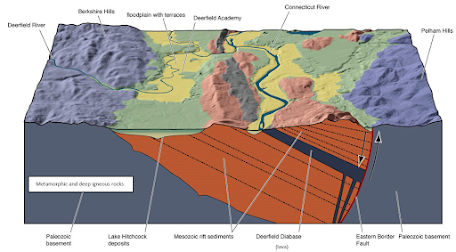This week's post takes us a little outside of the Hudson Valley and over to the Connecticut Valley in Massachusetts. Specifically, to a town named Greenfield right on the Connecticut River and only about 12 miles or so south of the Vermont border. At Greenfield, the Connecticut River tumbled over Turner Falls where some neat rocks are exposed from the early Jurassic Period of geologic time.
Now we've all heard of the Jurassic because of the Jurassic Park movie franchise, but I wasn't visiting Greenfield to see dinosaur remains (although there are some trackways in the area) but rather to look at lowly mud balls. These aren't ordinary mud balls, however, but quite unique armored mud balls fossilized in those Jurassic-aged rocks.
During the Jurassic Period, the supercontinent of Pangaea was rifting apart. As Africa rifted away from North America to form the Atlantic Ocean, the crust stretched a bit further inland as well forming what are known as continental rifts (similar to the East African Rift today). The Connecticut Valley is one such continental rift from that period of time.
Below is a figure showing the geology of this area.
Now I could write a number of blog posts about the geology shown here, everything from basalt lavas pouring from deep faults to dinosaur trackway mysteries, to massive post-glacial lakes but today's topic are the mud balls.
Picture yourself standing in north-central Massachusetts some 200 million years ago. You're on the shore of a large shallow lake. It's a hot, arid climate and, off in the distance, you see some lavas flows erupting from a fissure at the base of some mountains. You're cautious, since two-legged therapod (meat-eating dinosaurs) are scouting around the area.
One afternoon, a distant thunderstorm drops some rain in the mountains. As water runs across the baked landscape, chunks of dried clay mud fall into the dry washes that are now filling with runoff from the rains and becoming streams. The streams flow down toward the lake, rounding off the chunks off mud as they tumble along. Becoming sticky, these mud balls pick up pebbles in the stream bed forming an armored coating around them. Finally, these armored mud balls come to rest in the sandy sediments of the lake bed (today known as the Turners Falls Sandstone).
A neat little story and not something that's normally preserved. Apparently, these types of mud balls are only known from about 10 places around the world. The best place to see them today is on the campus of Greenfield Community College which has a very neat Geology Path showing rocks of the area and some great examples of these mud balls.
Here are some pictures...







No comments:
Post a Comment